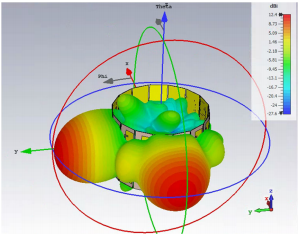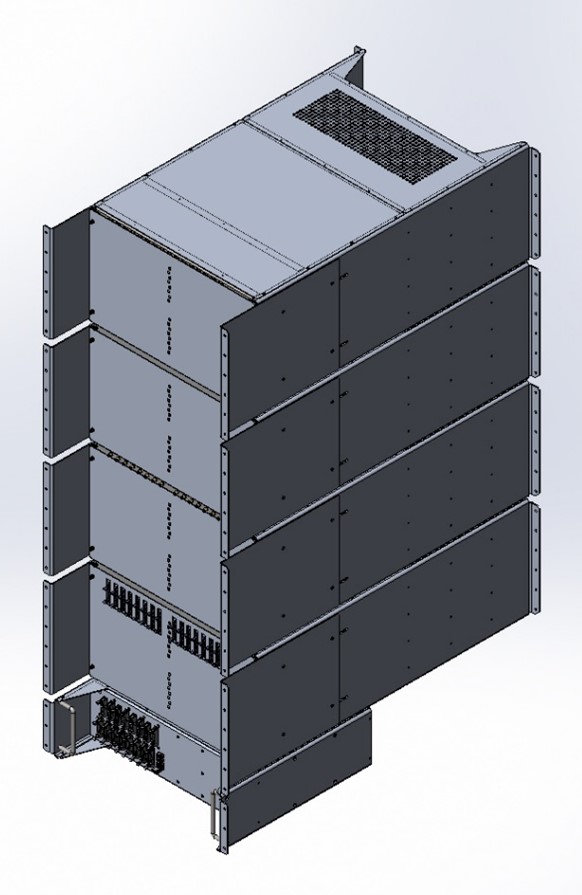AESAs: Active Electronically Steered Arrays
May 2021In previous posts, we learned that antenna arrays consist of multiple radiating elements. Beamformers are corporate power dividers that sometimes feed arrays. We also learned that are two main types of beamformers: conventional and adaptive. The simplest form of beamformer is a power division network, which yields a fixed radiation beam. If the beamformer incorporates controllable phase or delay elements, a steerable beam array or phased array results.

Circular Array
AESA stands for Active Electronically Scanned Array or Active Electronically Steered Array.
Primarily used in radar systems, an AESA is a type of computer-controlled phased array antenna in which the beam of radio waves can be electronically steered in different directions without physically moving the antenna.
Although AESAs have strong directional capabilities, as well as employ beamforming technology, they are not to be confused with smart antennas, which use computer-generated signal processing algorithms to change signals.

While beamforming and beamsteering are linked techniques, it is important to note that beamsteering takes beamforming a stage further, by altering the beam pattern through changing the signal phase in real time without changing the antenna elements or hardware. Furthermore, true-time-delay beamsteering, which JEM Engineering’s AESAs feature, allows the array to maintain its beam pointing angle over multi-octave bandwidth.
While the first AESA systems were developed in the 1980s, their origins can be traced to the 1960s.
The AESA’s predecessor, the passive electronically scanned array (PESA) is a solid state system in which all the antenna elements are connected to a single transmitter/receiver and uses phase shifter modules to selectively delay certain parts of the signal, while allowing others to transmit without delay.
The PESA’s main limitation is that it can only emit a single beam of radio waves at a single frequency at a time. In order to emit multiple beams, the PESA must utilize the Butler matrix, a type of beamforming network.
Unlike the PESA, the AESA uses many transmitter/receiver modules, which are interfaced with the antenna elements, producing multiple, simultaneous radar beams at different frequencies. Also, since each module operates independently of the others, single failures have little effect on the operation of the system as a whole. Additionally, the modules individually operate at low powers, eliminating the need for a large high-voltage power supply.

Circular Array w/ Multiple Simultaneous Beams

MultiBeam Rack with Thread Injection
AESAs provide high situational awareness, making them especially useful in EW applications.
AESAs can change frequencies with relative ease. This capability, coupled with the AESA’s ability to distribute multiple frequencies across a wide band, even within individual pulses, make AESAs more resistant to jamming techniques than their less adaptive counterparts.
Another advantage is that AESAs boast a low probability of intercept by an enemy radar warning receiver (RWR). An RWR system issues a warning when it detects a radar signal that might pose a threat. AESAs’ ability to chirp effectively counteracts RWRs. To put simply, chirp pulses “compress” long duration frequency-coded pulses into a narrow pulses of greatly increased amplitude. An AESA’s chirps can not only change frequency very quickly, but also in a totally random sequence, making it quite difficult for an RWR to distinguish an AESA radar beam from ambient “white noise” radio signals.
JEM Engineering develops AESAs for fixed‐site, vehicular, and airborne applications.
Employing patented, proprietary, and SBIR technologies, these arrays offer many features not available with other arrays.
We also design electro-mechanical beamformers, which are radiofrequency passive devices for high-power handling capabilities.

Planar Array
Latest Posts

Hedy Lamarr: The Hollywood Actress Who Changed Wireless Technology
This Women’s History Month, we wanted to highlight the life and career of Hedy Lamarr, a famous Hollywood star whose lesser-known achievements include essentially laying the foundations for the spectrum-hopping technology we know today as WiFi.

Living Legends: James West and Jesse Russell
Every February, JEM Engineering honors the the African American Engineers who have made lasting contributions in STEM. This year, we’re excited to spotlight two living legends: James Edward West and Jesse Eugene Russell.

11 Ways the Antenna Industry Has Changed
In this issue, we wanted to reflect upon how the antenna industry has evolved over the past several decades.

Part II: Inspecting & Testing Antennas with UAVs
In this issue, we focus on how UAVs are used for inspecting and testing antennas. Perhaps an antenna is situated in a less-accessible area.
